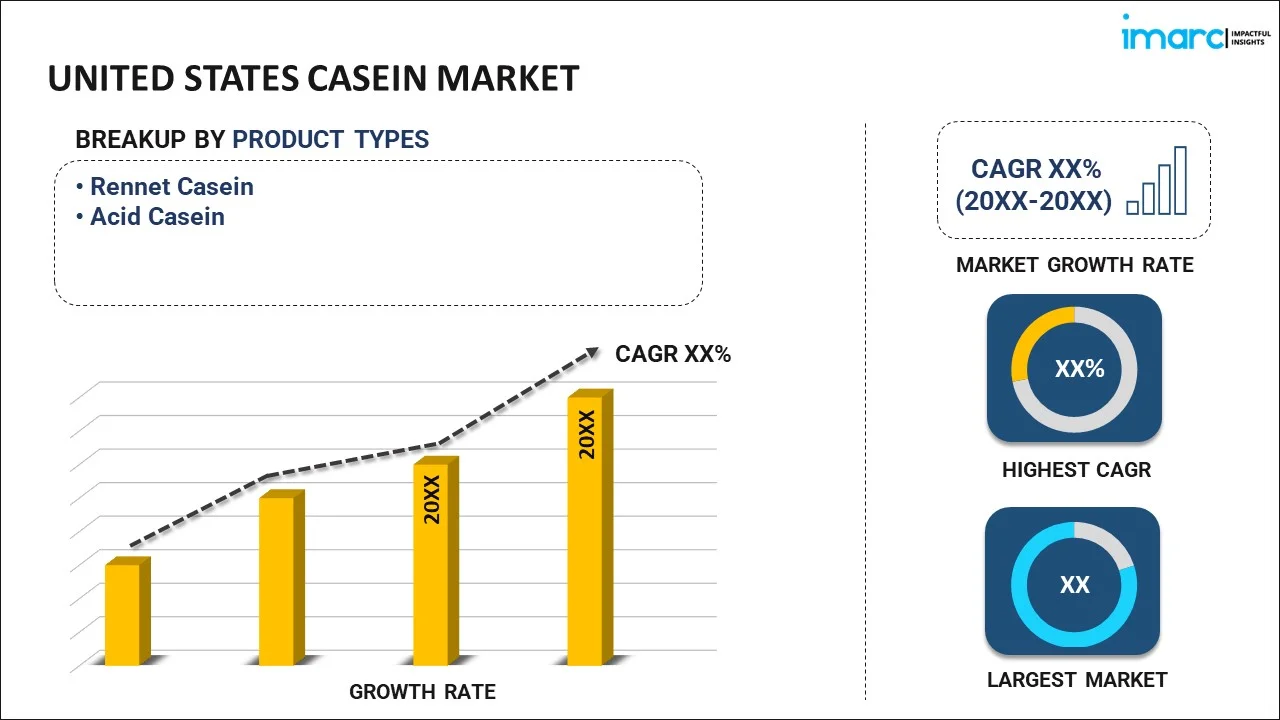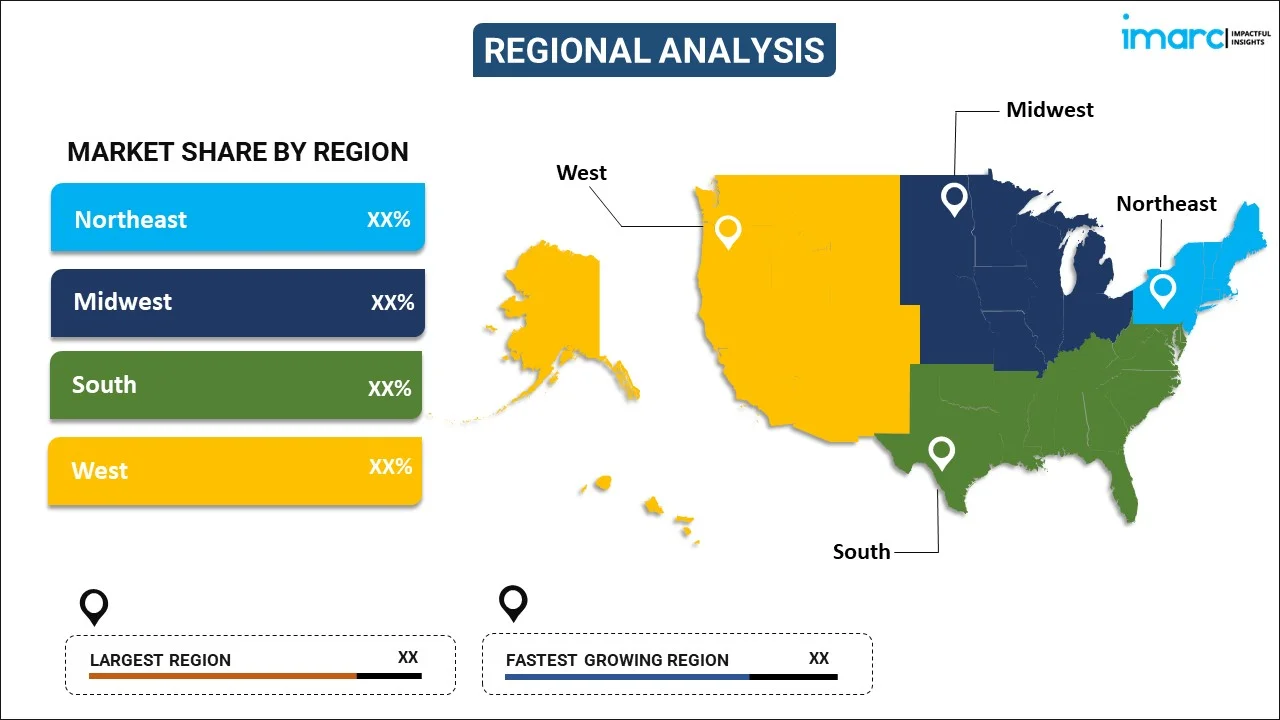
United States Casein Market Report by Product Type (Rennet Casein, Acid Casein), End Use (Food and Beverages, Pharmaceuticals, Cosmetics, Industrial, and Others), and Region 2025-2033
Market Overview:
The United States casein market size reached 43.9 Thousand Tons in 2024. Looking Forward, IMARC Group expects the market to reach 59.6 Thousand Tons by 2033, exhibiting a growth rate CAGR of 3.27% during 2025-2033.
|
Report Attribute
|
Key Statistics
|
|---|---|
|
Base Year
|
2024
|
|
Forecast Years
|
2025-2033
|
|
Historical Years
|
2019-2024
|
|
Market Size in 2024
|
43.9 Thousand Tons |
|
Market Forecast in 2033
|
59.6 Thousand Tons |
| Market Growth Rate 2025-2033 | 3.27% |
Casein refers to a protein found in the milk of mammals, such as cows, buffalo, sheep, yak and goats. It is commonly available in acid, rennet and caseinate variants. It contains essential amino acids, calcium, carbohydrates and phosphorus. Casein is a tasteless, amorphous and odorless white solid that forms a gel in the stomach to slow down the absorption and digestion rate. It aids in boosting muscle growth, increasing metabolic rate, improving digestion, delaying hunger and supporting muscle recovery. It finds extensive application across various industries, such as pharmaceuticals, cosmetics and food and beverage.
The growth in the United States casein market can be attributed to its widespread utilization in the manufacturing of caseinate products. Casein is also utilized as a key ingredient in coffee whiteners, instant breakfasts, milk and nutritional beverages. The increasing health consciousness among consumers is also favoring the market growth. Casein is low in calories and contains essential nutrients required for the optimal growth of the body. The rising consumer demand for protein-rich food products, such as yogurt, cheese, milk, butter and ghee, is also providing a thrust to the market growth. Moreover, the widespread product adoption in the food and beverage industry is positively impacting the market growth. Casein is widely used in various processed food products, such as puffed snacks, formulated meat products, baby food, infant formula, whipped foods and sports nutrition products. Other factors, including the increasing preference for dietary supplements, are anticipated to drive the market toward growth across the country.
Key Market Segmentation:
IMARC Group provides an analysis of the key trends in each segment of the United States casein market report, along with forecasts at the country and regional levels from 2025-2033. Our report has categorized the market based on product type and end use.
Breakup by Product Type:

- Rennet Casein
- Acid Casein
Breakup by End Use:
- Food and Beverages
- Pharmaceuticals
- Cosmetics
- Industrial
- Others
Breakup by Region:

- Northeast
- Midwest
- South
- West
Competitive Landscape:
The competitive landscape of the industry has also been examined along with the profiles of the key players.
Report Coverage:
| Report Features | Details |
|---|---|
| Base Year of the Analysis | 2024 |
| Historical Period | 2019-2024 |
| Forecast Period | 2025-2033 |
| Units | ‘000 Tons |
| Segment Coverage | Product Type, End Use, Region |
| Region Covered | Northeast, Midwest, South, West |
| Customization Scope | 10% Free Customization |
| Post-Sale Analyst Support | 10-12 Weeks |
| Delivery Format | PDF and Excel through Email (We can also provide the editable version of the report in PPT/Word format on special request) |
Key Questions Answered in This Report
The United States casein market reached a volume of 43.9 Thousand Tons in 2024.
We expect the United States casein market to exhibit a CAGR of 3.27% during 2025-2033.
The growing consumer awareness towards several health benefits of casein in enhancing muscle growth, increasing metabolic rate, improving digestion, etc., is currently driving the United States casein market.
The sudden outbreak of the COVID-19 pandemic has led to the shifting consumer preferences from conventional brick-and-mortar distribution channels towards online retail platforms for the purchase of casein-based products.
Based on the product type, the United States casein market has been segmented into rennet casein and acid casein. Currently, rennet casein represents the largest market share.
Based on the end use, the United States casein market can be bifurcated into food and beverages, pharmaceuticals, cosmetics, industrial, and others. Among these, the food and beverage sector currently accounts for the majority of the total market share.
On a regional level, the market has been classified into Northeast, Midwest, South, and West, where South currently dominates the United States casein market.
Need more help?
- Speak to our experienced analysts for insights on the current market scenarios.
- Include additional segments and countries to customize the report as per your requirement.
- Gain an unparalleled competitive advantage in your domain by understanding how to utilize the report and positively impacting your operations and revenue.
- For further assistance, please connect with our analysts.
 Inquire Before Buying
Inquire Before Buying
 Speak to an Analyst
Speak to an Analyst
 Request Brochure
Request Brochure
 Request Customization
Request Customization




.webp)




.webp)












